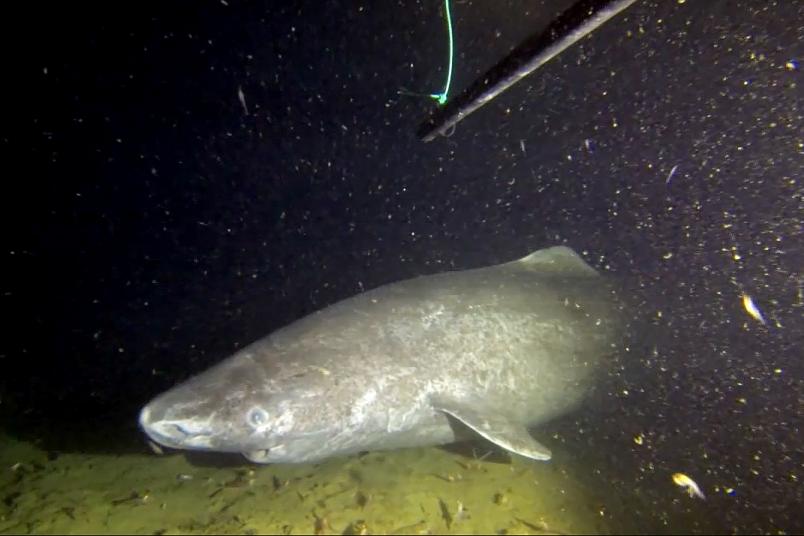Biology How to Live 400 Years
An international research team has decoded the genome of the longest-lived known vertebrate: the Greenland shark. It is huge and has special repair capabilities.
The Greenland Shark (Somniosus microcephalus), an elusive dweller of the depths of the northern Atlantic and the Arctic Ocean, is the world’s longest-living vertebrate, with an estimated lifespan of about 400 years. An international team of scientists has mapped the Greenland Shark’s genome for the first time. “The analysis of the data suggests that improved DNA repair could play an important role in its extreme longevity,” says Professor Arne Sahm, Faculty of Biology and Biotechnology at Ruhr University Bochum, Germany, and first author of the paper, which was published on September, 11, 2024 on the bioRxiv platform. The team’s work to decode the animal’s genetic makeup will shed new light on general mechanisms enabling longevity.
A huge genome
Only a few complex animals can outlive humans. Astounding examples are giant tortoises, like Jonathan, a 191-year-old specimen currently residing in St. Helena. Yet, this record pales compared to the Greenland Shark.
The shark’s genome size posed one of the project’s early challenges. With 6.5 billion base pairs, the Greenland Shark’s genetic code is twice as long as that of a human, and it is the largest among shark genome sequences to date. “There are only a few animals sequenced thus far that have an even larger genome,” says Arne Sahm, the study’s first author, referring to the axolotl and recently published lungfish genome studies. As for the axolotl and the lungfish, the massive Greenland Shark genome size is primarily due to the presence of repetitive and frequently self-replicating elements. Such transposable elements, sometimes called jumping or selfish genes and often considered genomic parasites, account for over 70 percent of the Greenland Shark’s genome. Interestingly, a high repeat content is often regarded as detrimental since jumping genes can destroy the integrity of other genes and reduce the genome’s overall stability. In the case of the Greenland Shark, however, the high repeat content does not appear to have limited its lifespan.
Hijacked jumping genes
On the contrary, Sahm and his colleagues suspect that the expansion of transposable elements may have even contributed to the Greenland Shark’s extreme longevity. Sometimes, other more functionally relevant genes can “hijack” the molecular machinery encoded by transposable elements to multiply. The team suggests that several regular genes seized this opportunity during the Greenland Shark’s evolution. Surprisingly, many duplicated genes are involved in repairing DNA damage. “In each of our cells, the DNA sustains damage thousands of times every day, and specialized molecular mechanisms constantly repair it. A remarkable finding of comparative genomic studies is that long-lived mammalian species are exceptionally efficient in repairing their DNA,” explains Alessandro Cellerino, a neurobiologist at FLI and the Scuola Normale Superiore (SNS) in Pisa. Thus, the team’s results indicate that DNA repair may represent a general mechanism underlying the evolution of exceptional longevity. “We are tempted to speculate that the evolution of the Greenland Shark has found a way to counterbalance the negative effects of transposable elements on DNA stability – by hijacking the very machinery of transposable elements,” adds Arne Sahm. The researchers are also eager to learn more about the mechanisms that control the spreading of transposable elements. “We can now start answering whether the silencing of transposable elements in Greenland Sharks is any different from that in other species,” says Helene Kretzmer from the Max Planck Institute for Molecular Genetics.
Modified control center
The team also found a specific alteration in the protein p53 – also known as the “guardian of the genome”. Strikingly, p53 acts as a control hub that responds to DNA damage in humans and in many other species. “This protein is mutated in about half of all human cancers and is the most important tumor suppressor we know. Therefore, it is an essential gene for longevity,” says Steve Hoffmann, a computational biologist at the Fritz Lipmann Institute on Aging (FLI) in Jena, Germany. However, further studies are needed to show to which extent the observed changes in critical genes (such as p53 and molecular pathways, e.g., duplications of DNA repair genes or changes in tumor suppressors) contribute to the animals’ exceptional longevity.
Clear the way for further studies
“Our genome project now provides a basis for many independent studies that will help us to better understand the evolution of this remarkable species,” underscores Paolo Domenici from CNR – IBF Pisa. “This is one of the reasons we decided to make the genome immediately available to the scientific community,” adds Alessandro Cellerino. The genome sequence and the corresponding web resources provided by the team enable researchers worldwide to analyze the Greenland Shark version of their genes of interest. “This work is a cornerstone for a better understanding of the basis of the Greenland Shark’s extreme physiology. Furthermore, it helps us assess their genomic diversity and thus the population size of this vulnerable species for the first time,” comments John Fleng Steffensen from the University of Copenhagen, who has been studying these giant animals in the field for the last fifteen years.
Understanding longevity better
“The Greenland Shark’s genome is a quintessential step for understanding the molecular mechanisms of aging in this exceptionally long-lived species,” says Steve Hoffmann. The researchers expect the Greenland Shark study to be essential for many other organisms. “Exploring the genetic underpinnings of the huge lifespan diversity across the tree of life offers an entirely new perspective for investigating the mechanisms enabling exceptional longevity,” explains Alessandro Cellerino.

